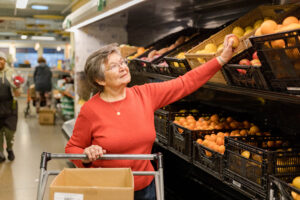Purchased vs. Donated Food —
In response to a request for comment by Food Bank News to its Editorial Advisory Board last month, Brian Greene, President and CEO of Houston Food Bank, supplied these thoughts on the topic of purchased versus donated food. His thoughts offer further perspective on this article, “How Some Food Banks Source Way More Donated Food,” published Nov. 7, 2023.
Food insecurity ten years ago was higher than what we have today. Yet food banks were distributing a lot less (4 billion pounds versus more than 6 billion now) and certainly purchasing a lot less despite need being higher. So why are food banks across the country reporting higher demand and the need to purchase more if need as measured by the Census Bureau is less than when we were distributing roughly half of what we do now? Why are we seeing greater levels of unmet need?
In my opinion, there is value in distinguishing between need and realized demand. Need can be defined as the income gap neighbors experience and is the difference between how much money struggling families have versus how much they need to get by. This income gap is always overall higher than what food banks can fill with food. This is why the calculated meal gap is never actually closed. Realized demand is the amount of food requested by our pantry system given the level of requests they receive.
Realized demand is always far less than need. Given that realized demand is less than need it is instead a function of how much the pantries can/will give, their policies (such how often someone can come) and how welcoming they are, combined with the neighbors’ ability/willingness to access the pantry system.
These variables have gradually risen over time, with the primary driver being the food banks’ collective ability to supply more. But the pandemic caused a large uptick in all of these variables as food banks were suddenly and significantly more generously supported, pantries or substitutes stepped up, curbside models reduced fear and stigma and whole new groups of people accessed the charitable food system. Realized demand surged.
That has changed expectations of what the food banks should be able to do from neighbors, pantries, the community and the food banks themselves. Realized demand has stayed high even though our resources have fallen significantly because expectations have changed. I’m not saying that inflation and the ending of pandemic related benefit enhancements are not hitting families with low incomes hard. The 31% increase in food insecurity proves that. But it is important to understand how much more complex food bank demand is.
It’s also important to note that high realized demand would not be driving the increase in purchasing if not for another impact of the pandemic. Many if not most food banks accumulated financial surpluses during the pandemic. Increased pressure to step up assistance, especially to provide those easy-to-distribute cans and boxes that were plentiful during the pandemic, is hard to ignore when there are extra reserves in the bank.
I am concerned though that responding to this higher realized demand as if it were a short-term phenomenon by spending reserves on purchasing is a response that food banks will regret.
Brian Greene
President and CEO
Houston Food Bank
Top 300 Food Banks
Re: “2023 Top 300 Food Banks, by revenue,” (published Oct. 24, 2023). Comment via LinkedIn: After spending a week surveying and interviewing over 100 people facing food insecurity, I wonder why a list like this is necessary or relevant to the work of food banks and the thousands of organizations working in this space.
People facing hunger are simply looking for organizations that provide a safe and dignified experience, and food that can provide health and well-being for them and their families. Every organization doing this work with their neighbors at the center are on my list of top organizations.
Jordan Vernoy, CNP
Adaptive Design Consultant
See What I Mean Consulting
FROM THE EDITOR:
Thank you for your take on our Top 300 Food Banks listing! You raise an interesting question: Why does Food Bank News publish such a list?
The answer is that we believe strongly that more information, not less, is beneficial to the hunger relief sector, and the goal of ending hunger.
Our listing offers a comprehensive view of all the major food-distribution entities working to eradicate hunger in our country. One of its biggest outcomes has been to identify and elevate the dozens of independent food banks around the country that operate outside the Feeding America network. We believe transparency around the full size and scope of the food banking network beyond Feeding America is necessary to effectively eliminate hunger. To use battle terms, how can we win the fight against hunger if we don’t even know how big our Army is?
Tracking the overall revenue of the largest 300 food banks over time, as we do, also offers perspective on the current status of the sector. Most recently, we found that overall food banking revenue (which is a reflection of the amount of good food banks can do, since revenue is largely based on in-kind food donations) narrowed by about $3 billion in the last fiscal year, after big gains during the pandemic. This makes a solid, research-based case for expanded government assistance for this sector.
Aside from providing the big picture, a comprehensive listing of food banks can be useful for understanding food distribution needs at the state or local level. (Our listing offers views of food banks by state.) A non-profit entity seeking to build a network of small food warehouses for the benefit of rural food distribution, for example, has found our listing to be “very helpful” to its efforts.
Finally, there is a lot of interest among people about the nation’s food banks. Every month, hundreds of people make their way to our site after searching, “Which food banks are the largest in America?” They all have their own reasons for asking that question, and we are happy to provide them with answers.
We agree wholeheartedly that people facing hunger simply want a dignified experience, and we applaud the food banking sector for providing that on a consistent basis. We also believe that more data about the sector as a whole can only improve outcomes for the food-insecure.
Thank you for your comment!
Chris Costanzo
Founder and Editor
Food Bank News
Like what you’re reading?
Support Food Bank News
This article was made possible by the readers who support Food Bank News, a national, editorially independent, nonprofit media organization. Food Bank News is not funded by any government agencies, nor is it part of a larger association or corporation. Your support helps ensure our continued solutions-oriented coverage of best practices in hunger relief. Thank you!
Connect with Us:









